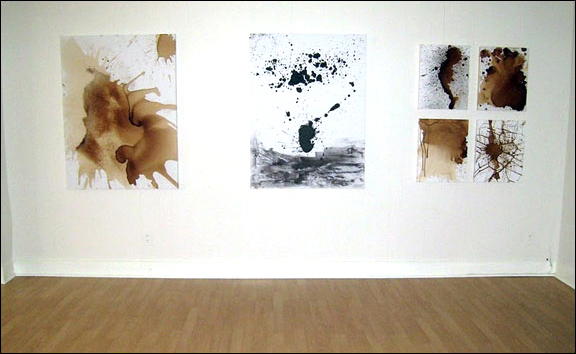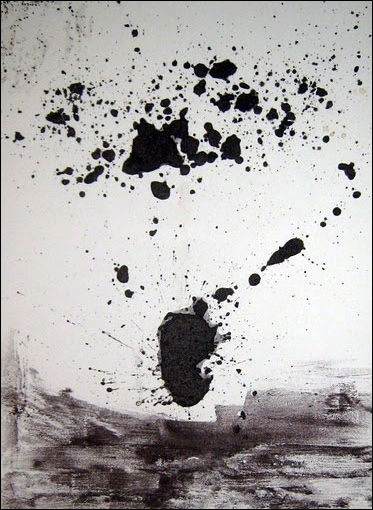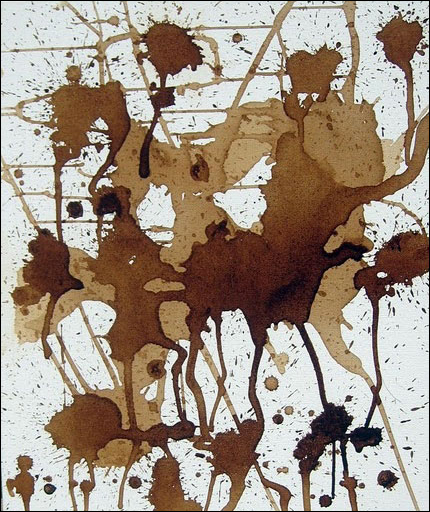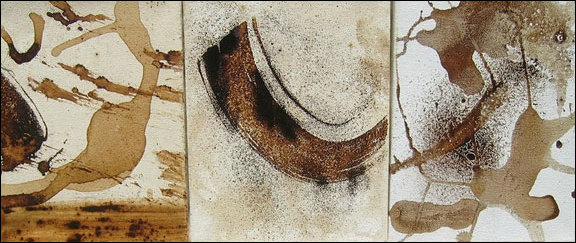John Perreault: Protests and Beauty
Honoré de Balzac poisoned his body with demitasse after nocturnal demitasse of coffee while Victor Hugo used coffee infusions to create delicate sepia tone drawings. Filippo Tommaso Marinetti referred to himself as, “the caffeine of Europe” and now John Perreault explores this earthy stimulant turned art supply. Coffee is the first of three unhealthy materials that Perreault transforms into rich and varied works for his exhibition Protests and Beauty at Gallery 125 in Bellport, New York.

Ordinary coffee inspired these European masters but Perreault takes inspiration from instant coffee, discovered by inventor and entrepreneur George Constant Louis Washington. Washington lived in nearby Brookhaven Hamlet, in a home now slated for demolition. During a bid to convert the old mansion into a cultural center, Perreault crossed paths with Washington’s story and resolved to employ instant coffee as an art material.

The works feel like action painting, calling to mind Perreault’s Pollock-inspired serpentine meandering lines in toothpaste (another unorthodox art supply). But these paintings reflect such a range of mark making, from strident, aggressive brushwork to subtle gradation, that coffee doesn’t really enter the viewer’s mind. Some images suggest complex networks of roots emanating from a central trunk while calligraphic figuration in other works conveys great energy and vibrancy. Some marks seem crystalline snowflakes (coffee crystals?) and others suggest passing clouds.

Also on view is a series of OSB Drawings or drawings on Oriented Strand Board. OSB, commonly known as chipboard, is a wood composite for construction made from bonding wood chips in formaldehyde-based resins. Formaldehyde is a known carcinogen, which makes this art material as dangerous as it is unusual. Throwing caution to the winds, Perreault traces selected wafers in the OSB with black ink to throw existing patterns into relief. In so doing, he lends notable aesthetic value to material ordinarily hidden beneath our floors.

Like much of the work in this exhibition OSB Drawings suggest Oriental influences, like abstracted ocean waves or showering rain patterns in a Japanese ukiyo-e print. Six manipulated OSB panels are exhibited as modular floor pieces, aligned straight on the wood flooring of the gallery. As a result, the intricate patterning of the wood grain carries figuration from the coffee paintings off the walls and into the physical space. In a side gallery hang four OSB drawings like leaves of an Eastern lacquered screen.

The artist also exhibits sand paintings, realized with black, petroleum-coated sand from Fire Island. Perreault was first drawn to this adulterated sand because of its distinctive color. A readymade art supply, the sand needn’t be mulled with linseed oil – it comes with it’s own pungent motor oil. The imagery, sometimes gestural, sometimes soft and nuanced, once again elevates the medium until it disappears, dematerialized by Perreault’s artistry.

So is there a message to be learned here? Perreault’s title for the exhibition suggests a morality play for our times. Were the Nuremberg Rallies, masterfully filmed by Leni Riefenstahl, any less beautiful because they were a gathering of Nazis? Was the burning World Trade Center any less ardent and captivating because thousands of people were trapped inside? Unfortunately beauty and truth don’t always seem to coexist in this world. Fast food, carcinogens and pollution don’t detract from the beauty and of Perreault’s new work. To my mind, however, there is less dichotomy and more alchemy in Protests and Beauty, Perreault having isolated a highly effective philosopher’s stone in art.
John Perreault’s Protests and Beauty was on view from July 23 – August 7, 2011 at Gallery 125, 125 Main Street, Bellport Village, New York 11713, Tel. 631-880-2693
© 2011 Daniel Rothbart. All rights reserved. First published in September 2011 in Artery.